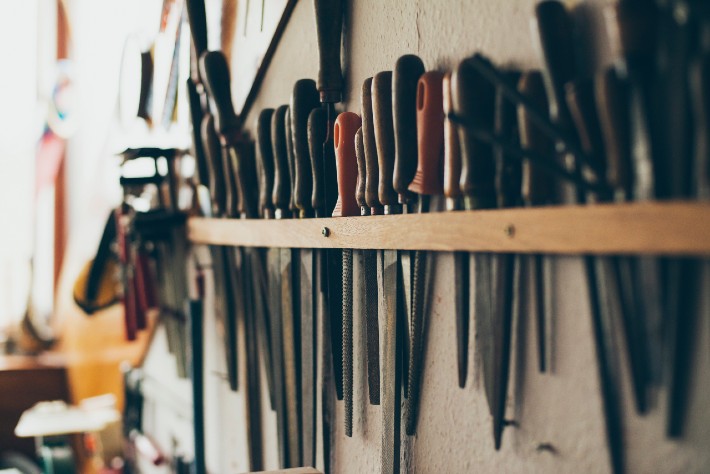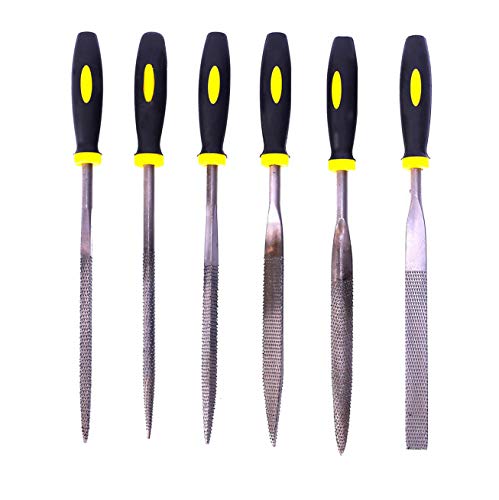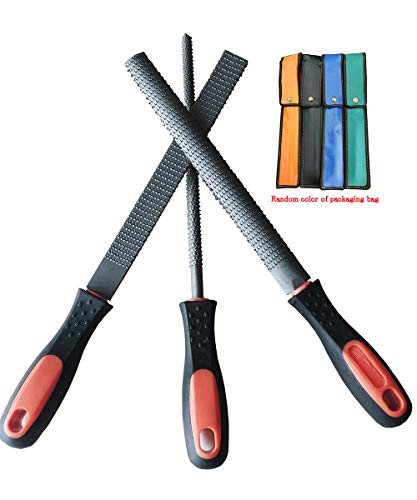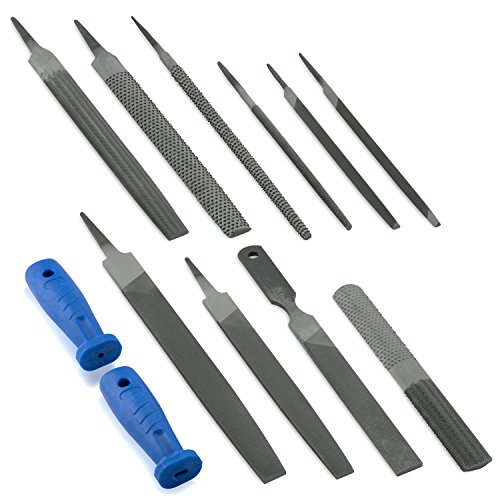Best Rasp Files – A Versatile Woodcarving Solution

Rasp files are essential woodcarving tools for a variety of reasons. They can be used for any sort of wood removal, wood cuts, or wood shears. They are quick, efficient, and can be employed easily to erase existing marks, perfect curvature, and fit other parts. Additionally, they can be used to repair other tools as well. All of these properties make rasps a must-have in your toolbox. There are numerous options available, so we have curated a special list for you to choose from for the best rasp files in 2023.
- Best Overall: Libraton Wood Rasp Shop Now ➔
- Runner Up: Fatmingo Mini Assorted Wood Rasp Shop Now ➔
- Honorable Mention: YCAMMIN 8 Inch Wood Rasp File Set Shop Now ➔
- Contender: Neiko Heavy Duty File and Rasp Set Shop Now ➔
- Also Consider: Newkiton 4 way Wood Rasp File Shop Now ➔
Best Rasp File of 2023 Reviewed in Detail
Best Overall
This double side flat rasp file comes with a whopping 28 extra pieces of sandpaper and assortment of grits. Made with premium grade heat treated alloy and carbon steel, it promises professional results at home. It has a soft and comfortable grip so your hands do not hurt while filing and soft back sandpaper at the other end that ensures a smooth, polished outlook.
Pros
- The double side provides filing for both steel and wood.
- The half round rasp makes filing circular surfaces very easy.
- The fully round wood rasp is effective at deburring holes.
Cons
- Kit size is a little large
Runner Up
This rasp file set comes complete with rubber handles and 6 different bastard files for wood and other soft stuff carving. These include a half round file, a round file, a triangular rasp, a square file, and 2 flat files. This file works specially with soft surfaces like plastics, 3D printed objects, or even soft metal.
Pros
- Alloy and carbon steel that makes the files durable and strong.
- Non slip rubberized handles for moist or wet conditions.
- Its small size easily sits in your toolbox.
Cons
- Might be a little pricey for some users.
Honorable Mention
This compact 3 piece set comes in a fun colored kit and includes a flat rasp, a half round and a hand cut round rasp. If you are looking for a portable set that you can take to your carving needs, this is the set to have! Used and declared by professionals as a must have, this set is both light and durable. It is particularly well used for furniture items like drawers, cupboards, or cabinets because of its ability to get into corners and difficult angles.
Pros
- Soft rubber handles to ensure a smooth grip
- High quality carbon steel rasp fixtures
- Sharp rasp teeth that shape wood for many years to come.
Cons
- Its finish might be a little ragged.
Contender
This rasp set is one of the most versatile ones out there. It is commonly used and advertised for heavy industrial usage and comes with 12 separate pieces of equipment. The kit includes 3 different rasps and 7 different files that help work with several materials while also providing varying levels of coarseness. Other than that, it also has 2 removable handles made from PVC that allow rasps and files to be conveniently interchanged while working.
Pros
- Ergonomically shaped handle which provides added control.
- Heat treated steel to provide a longer service life.
- Manufacturer’s warranty for 100 percent customer satisfaction.
Cons
- Might be unnecessary for limited usage.
Also Consider
Contrary to other sets, this file is unique in form and shape and comes as a single tool with 4 different sides of files. Its flat file is perfect for blade sharpening and edge smoothing while the round side provides for contouring holes, openings, rings, and other circular objects. If you are looking for a small all purpose file that fits both in the palm of your hand and your pocket, get the Newkinton 4 way, and get going!
Pros
- High quality carbon steel body for maximum filing strength.
- Stainless steel finish so your file remains rust free.
- Compact weight of 5.6 ounces making it light and easy to use.
Cons
- Might be difficult to hold
Best Rasp Files Buying Guide
If you love to work with wood and get crafty with your furniture or even if you just own a toolbox that you occasionally take out to do small repairs around the house, a rasp file is a useful arrow in your quiver. Use it to shape and mold wood or just scrap rough metal to smoothen it. Or, create crevices in pvc pipes to hold fittings and joints. The rasp is the jack of tools and it’s essential that you choose one that fits your needs. And to help you through it, we have created an extensive buying guide to make your choice easy and effective!
Types of Rasps
Rasps are classified according to their size, shape, and teeth density and each is used for different materials and functions. Therefore, it is necessary to know what you want to use a rasp for when buying it. So let us break down different types of rasps for you.
Cabinet rasp
Cabinet rasps are usually used for small, soft pieces of wood. They are used by professional furniture makers to smooth out spots in a manner that does not harm the wooden surface or finish. Some cabinet rasps come with pointed ends that act as picks to take out extra chunks of wood that result from rasping and lie in crevices.
Square rasp
Square rasps are usually flat and have a square cross section. However, sometimes they are knife shaped and narrow at the end to fit into holes and openings. Square rasps are used for thin and flat surfaces and square holes. They come in a variety of sizes too so you can choose according to the length of your surface or the depth of your hole.
Modeler rasp
A modeler’s rasp is used to make extremely precise cuts and intricate pattern work often found on ornate woodwork and furniture. It is sharp at the end with a flat base surface and a long handle to provide dexterity and accuracy. Modeler rasps are best employed when creating projects that require delicate work like architectural prototypes or sculptures.
Horse rasp
Horse rasps, as suggested by their name, are outdoor instruments used to file horse hooves, getting dirt and grime out of farmyard applications. They are usually flat and thick and have two filing faces with varying teeth that can help scrape off both large pieces of dirt and smaller dust particles. However, they are also well applied on flat surfaces like wooden walls and doors.
Rasps with cranked necks
Cranked necked rasps are similar to paint scrapers and have long flat files attached to handles through cranked tangs. The curvature of the neck is useful for curved or bent surfaces where confinement is an issue.
Needle rasps
Needle rasps are as thin as, well you guessed it…needles! They are relatively small and allow for extremely delicate work. Often, needle rasps are made to operate on musical instruments like the violin, the viola, or the guitar. Needle rasps usually come in packs of 4 or 6.
Round rasps
Round raps are similar to needle rasps but are thicker and hollow with a round cross section. They are employed to smooth out wooden or metal curves. They are also used to make new holes and clear them up for screw fittings or other wooden structures. Round rasps are durable instruments, often made with hardened steel and so sometimes resemble a long, round grater. Their results are precise and efficient and faster than other, more common rasps.
How To Choose a Rasp File
There are specific features to look out for when buying a rasp because they determine the quality and usage of the rasp. Some of these are:
Type of teeth:
If you are looking for a highly smooth finish that looks impeccable and ornate, go for a fine teeth pattern. If you want a regular repair job rasp that can be utilized for other purposes, an average sized teeth density will do just as well. And if you need to remove materials quick and fast, a coarse rasp will work best.
Profile:
After knowing your teeth density, you should pick out the size and shape of your rasp. A flat rasp works well on planes without curves or ridges. A round rasp, also known as a rat tail, is used for finishing up niches and notches as well as other irregularly shaped objects. However, if you are looking for a rasp that meets both these needs in a single tool, go for a half-round rasp that sports both flat and round surfaces.
Handles:
Rasp handles are often made of either wood or other synthetic materials like plastic or pvc. Ergonomic and long handles provide for greater comfort and dexterity. Some handles are detachable and can be fixed onto other rasps so you quickly change tools while on the job.
Some More Tips:
If you want to go a little more versatile, always go for a rasp that is multi-sided. Rasps with 2 or 4 faces are often available. In addition, sets of rasps are also available that come with one of each.
You should also remember to use rasp teeth as fit for your work because any material you file away will be lost. So, choose wisely!
General purpose rasps are uniform in teeth density and depth, and can often leave the filed surface ragged and uneven, requiring a significant amount of clean up. So do not choose them for surfaces you want to put on display.
High-quality rasps, often called pattern makers because of their smooth finish, have staggered high-density teeth that leave the surface soft to touch and clean to look at. However, they can be a bit expensive so get these if you are looking for specific activities.
How Much Does a Rasp Cost?
Rasp files come at a variety of costs, some extremely cheap, others a fine work of art and priced as such. However, you can get a good one that is in your price range and includes the features you want!
If you’re not sure how to use a rasp file, this video from Scrap wood City may help:

Inexpensive rasps:
The cheapest rasps are readily available for 6 to 8 dollars. They might not have the best finish but work really well with coarse materials and hard surfaces. Their handles are moderately comfortable too.
Mid ranged rasps:
Second-tier rasps are about 15 to 20 dollars. They have much better handles and a considerably larger teeth density. They provide relatively neat finishes and are more efficient too.
Expensive rasps:
These are top-of-the-line, pedigree rasps. They go to about 110 dollars and can give beautiful finishing touches to models, instruments, and sculptures, enhancing their quality many more times. If you are quite the artist and perfectionist, this might be a good long-term investment.
Conclusion
As we’ve seen, having a rasp within reach is extremely important. Your toolbox, much like your repair jobs would be vacant without it. So choose the best one that fits your needs, trust in yourself, and give it a go!
People Also Asked
Can a woodworking rasp be used on metal?
It is advised to use a rasp that is specifically tailored for metal surfaces. While woodworking rasps may work on metal, their teeth would dull out and their surface life would be reduced.
What is the difference between a rasp and a file?
A file is typically used for metal works while a rasp is used for wood. Rasps can be put directly on surfaces and cover a larger area while files have to be faced perpendicular.
Can a rasp be used as a grate?
Rasps with larger teeth are sometimes used as grates for certain hard cheeses, shallots, garlic, ginger, nutmeg and other spices. However, keep your kitchen rasps separate from your work rasps or your dinner is going to taste a little off!
Article Contributors
The Woodsmith Review Team’s product reviews and in-depth guides are here to help you choose the best tools and gear to build great-looking projects confidently. Woodsmith is reader-supported: When you buy through links on our site, we may earn an affiliate commission. Large language models (like Artificial Intelligence) may have been used in the research and creation of the content.
Inquiries regarding specific articles or product testing should be sent to aimperiapt@gmail.com





